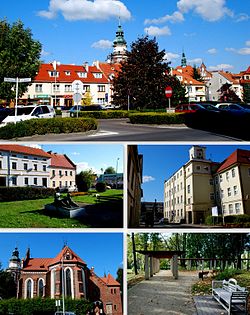| Syców | |
|---|---|
 | |
 Flag Flag Coat of arms Coat of arms | |
| Motto(s): Niech pomyślność miasta rozkwita tak, jak zacność jego obywateli Let the town's prosperity grow like the nobility of its citizens | |
 | |
| Coordinates: 51°18′36″N 17°43′25″E / 51.31000°N 17.72361°E / 51.31000; 17.72361 | |
| Country | |
| Voivodeship | Lower Silesian |
| County | Oleśnica |
| Gmina | Syców |
| Established | 13th century |
| Town rights | 1369 |
| Government | |
| • Mayor | Dariusz Maniak |
| Area | |
| • Total | 17.05 km (6.58 sq mi) |
| Population | |
| • Total | 10,397 |
| • Density | 610/km (1,600/sq mi) |
| Time zone | UTC+1 (CET) |
| • Summer (DST) | UTC+2 (CEST) |
| Postal code | 56-500 |
| Area code | +48 62 |
| Car plates | DOL |
| Website | http://www.sycow.pl |
Syców (German: Groß Wartenberg, until 1888 Polnisch Wartenberg) is a town in Oleśnica County, Lower Silesian Voivodeship, in south-western Poland. It is the seat of the administrative district (gmina) called Gmina Syców and part of the larger Wrocław metropolitan area.
It lies approximately 27 kilometres (17 mi) north-east of Oleśnica, and 47 kilometres (29 mi) north-east of the regional capital Wrocław.
History

Located within Poland since the establishment of the state in the 10th century, the settlement was first mentioned under the Old Polish name Syczowe in a document issued by Polish Duke Henryk IV Probus in February 1276. The name comes from the old Polish name Syc, who possibly was the owner of the settlement. According to another theory as well as folk traditions, the name comes from the Polish word "syty". Soon after it also appeared under the name Wrathenberc, when a local castellan on the trade route to Kalisz in Greater Poland was documented. In the early 14th-century Liber fundationis episcopatus Vratislaviensis it appears under the names of Syczow and Wartinbergk. After the fragmentation of Poland in 1138, Syców was part of the duchies of Silesia, Głogów (from 1291) and Oleśnica (from 1312). It was granted town rights before 1312. Duke Konrad I of Oleśnica, who inherited it in 1321, fell under Bohemian suzerainty as a vassal of King John of Bohemia in 1329, however the town remained under rule of local Polish dukes of the Piast dynasty until 1489.
During the war for the Bohemian throne, local dukes sided with Poland, however, Hungarian King Matthias Corvinus forced the town to swear allegiance to him in 1480, and it fell under Hungarian suzerainty. In 1489 Matthias Corvinus took the town from Duke Konrad X the White and established the state country of Syców/Wartenberg enfeoffed to the Haugwitz noble family. In 1490 it passed to Jagiellonian-ruled Bohemia. The town was inhabited mostly by indigenous Poles, but also by Germans and Jews.

During the Thirty Years' War the town was captured by various armies numerous times. It was captured by the Saxons in 1632, the Austrians and again the Saxons in 1634, who withdrew after the Peace of Prague in 1635, then it suffered a fire in 1637, and was captured by the Swedes in 1642, 1643, 1646 and 1648. The town became depopulated, some inhabitants took refuge in nearby Poland, while others died.
From 1684, a postal route connecting Warsaw and Wrocław ran through the town, and in the 18th century, one of two main routes connecting Warsaw and Dresden also ran through the town; Kings Augustus II the Strong and Augustus III of Poland traveled that route often. In 1734 it was acquired by Ernst Johann von Biron, whose descendants held Wartenberg even after the Prussian annexation of Silesia in 1742, until they were expelled in 1945. From 1871 to 1945 part of Germany, in 1888 the Germans changed the name of the town from Polnisch Wartenberg to Groß Wartenberg to remove traces of Polish origin. Despite increasing Germanisation by the German authorities, Poles still formed the majority of the county in the late 19th century. After World War I, the Treaty of Versailles divided the county in half between Germany and the restored Polish state, leaving the town itself in the former. It was eventually reintegrated with Poland after World War II in 1945.
Notable people
- Karl Friedrich Lessing (1808–1880), painter, spent his childhood at Polnisch Wartenberg
- Jack Gielzak (1809–1862), botanist
- Oleg Nepomnyashchiy (born 1940), was granted honorary citizenship by the Gmina Syców
- Marta Gielzak (born 1954), ice speed skater
- Krzysztof Palczewski (born 1957), Polish-American biochemist
- Annia Gielzak (born 1969), actor
Twin towns – sister cities
See twin towns of Gmina Syców.
References
- "Population. Size and structure and vital statistics in Poland by territorial division in 2019. As of 30th June". stat.gov.pl. Statistics Poland. 2019-10-15. Retrieved 2020-02-14.
- ^ "Historia". Miasto i Gmina Syców (in Polish). Retrieved 16 February 2020.
- ^ Zbigniew Filipiak, Historia Sycowa (in Polish)
- "Informacja historyczna". Dresden-Warszawa (in Polish). Retrieved 16 February 2020.
External links
- (in Polish) Polnisch Wartenberg - Groß Wartenberg - Syców
- Jewish Community in Syców on Virtual Shtetl
| Gmina Syców | ||
|---|---|---|
| Town and seat |  | |
| Villages | ||